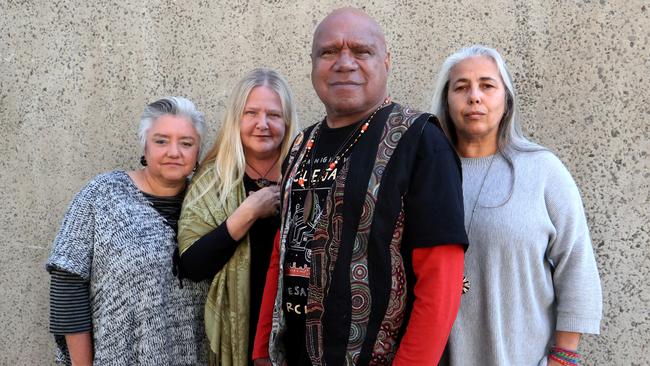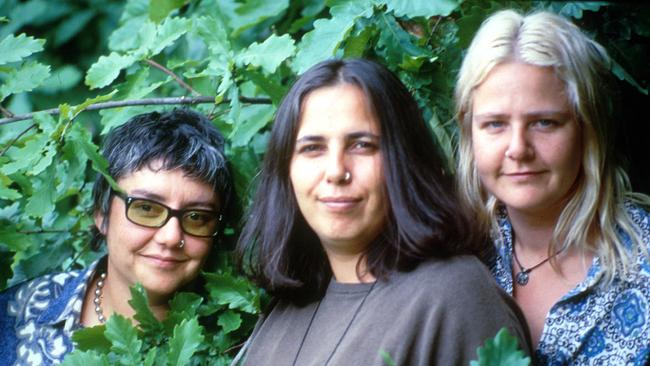Archie Roach and Tiddas: Dancing With My Spirit
The paths of Archie Roach and Tiddas continue to cross, more than 20 years down the track.

This is a story coloured by crushing disappointment and sheer euphoria. A story of seven strong lines, tightly intertwined and stretched across almost three decades, coming together to tell a tale whose ending has not yet been written. It is a story about the healing power of the human voice, and of its ability to provoke tears of sadness and joy.
A key thread of this shared yarn began to unwind on August 10, 1990, at a community event in inner-city Melbourne. During a weekend of womanly song, dance and storytelling named Hot Jam Cooking, three singers were in dire need of a name for their group.
Having performed previously as part of a 12-piece rock band named Djaambi, the trio was testing the waters with a new venture where the vocals would be front and centre rather than hidden behind noisy instruments.
Ruby Hunter — a musician who became the first indigenous Australian woman to sign a recording contract with a major record label — was unimpressed with the trio’s first offering, Girls from Djaambi. It didn’t sound right at all because that word means brother in Koori English. Hunter’s suggestion was elegant in its simplicity: Tiddas, a Koori word that means sisters. Perfect.
With that, the trio performed for the first time at Hot Jam Cooking. As a folk group built on a foundation of stirring vocal harmonies and acoustic guitar, Tiddas released four albums between 1993 and 1999, and toured with artists such as Midnight Oil, Bob Geldof and Billy Bragg. Their first EP, 1992’s Inside My Kitchen, was named for the locale where they began singing together, for an audience of just three.
That day in August each year is quietly marked by the three Tiddas members — Lou Bennett, Amy Saunders and Sally Dastey — who exchange gracious text messages and phone calls to mark the birthday of their collaboration, as named by Hunter, whose partner was Archie Roach, a quiet figure with a honeyed voice who then loomed large in the world of Australian Aboriginal song, as he still does.
■ ■ ■
After the release of his ARIA award-winning 1990 debut album Charcoal Lane and its follow-up, 1993’s Jamu Dreaming, Roach continued to write music in earnest. Toward the end of 1994, he recorded a collection of songs on his portable cassette player. Consisting of just voice and guitar, the cassette had no title other than Album Number Three when it was presented to Jen Anderson in early 1995.
“His voice and the lyrics in the songs, and the simplicity of the way they were presented, just made them really shine to me,” says Anderson, a Melbourne-based musician who has performed with acts such as the Black Sorrows and Weddings, Parties, Anything.
“They were all stories around the ties of his family, love and loss, and also his intimate connection with spirit and country.”
Anderson was one of few female producers working in Australia at that time, and when she was asked by Roach’s record label to work on pre-production for the upcoming third album she was thrilled.
She gave herself the brief to keep the songs in their natural form as much as possible, while offering gentle embellishments courtesy of an empathetic band. After recording the instruments, she decided to ask Tiddas to write and perform backing vocals, a request that thrilled the trio.
“I knew we were doing a top-notch job on that album — and it was fun,” Dastey recalls. “It’s really fun to create shapes with the harmonies, and the three of us were all in that same headspace. Top of our game; really into it. And it was magic. We knew it was special.”
Imagine the acute disappointment, then, when the parties involved learned that the record label had decided to go with another producer for what ultimately became an album named Looking for Butter Boy. Although Roach’s third album, released in 1997, won ARIA awards in the categories for adult contemporary and best indigenous release, its sound was very different to what Anderson had envisioned when she tapped Tiddas for their unique vocal talents.
“It really was one of our finest recording moments,” Bennett says. “But unfortunately it never got a guernsey. It was really heartbreaking. What have we done wrong? Have we oversung on it? Have we not done the right thing? You have to put those things to bed or otherwise they’ll eat away at you.”
The producer of that untitled collection of songs has another perspective on that disappointment. “I can really say why they felt crushed,” says Anderson, “Because for them singing — and for me producing — you’re really putting something of your inner self on record; on trial, almost, when it’s pre-production like this. So to then be rejected, it does have that extra personal element to it because it’s almost like it’s a rejection of your creativity. It’s part of your innermost soul.”
■ ■ ■
For 22 years, those recordings remained unheard, as the original ADAT tapes gathered dust on a shelf somewhere.
Tiddas disbanded in 2000 following a national tour in support of their fourth album, named Show Us Your Tiddas. Anderson continued to collaborate with Roach, and from time to time the subject would come up in conversation with his manager, Jill Shelton.
“Jill is always looking for things to do with Archie, so it’s not just performing live,” Anderson says. “She’s a great strategist; she’s always thinking ahead about what might be good for him next. I just happened to ring her, every now and again, and she said: ‘I think it’s time. We’re going to release this record.’

“She decided we would do it on our own, without any record company assistance. I think she felt the time was right, and I really trust her intuition with those sorts of things.”
Hers is the seventh thread of these intertwined stories, in addition to those belonging to Roach and Hunter, Anderson, and the members of Tiddas. Shelton managed the trio for most of its career; she and Anderson also lived together during the mid-1990s, and the regular presence of the Tiddas in their shared home was part of the reason the producer asked the three women to record backing vocals for the then-untitled Roach album.
Through the years these seven lines have overlapped and intersected; never severed, only strengthened, although Hunter’s sudden death in 2010 from a heart attack at the age of 54 was a blow to each of them.
“We think about Rube often, with or without Arch,” says Bennett of the woman who named the trio. “Mum and Dad, as they were referred to, or Aunty and Uncle; they were peas in a pod.
“It was very rare that you would see Archie without Rube, and vice versa. We miss her dreadfully — and if we miss her dreadfully, so must Arch.”
■ ■ ■
After all those years, what was once an untitled collection of songs recorded on to a portable cassette player is now a wonderful, lively album named Dancing With My Spirit. For the songwriter, hearing those compositions again provoked fond memories dating back to late 1994.
“It was a good time in my life,” Roach says. “To look back at those songs is like a time capsule; remembering that time, recording those songs with those musicians. Just listening to the songs, I was in a good place, and a good frame of mind. It was some of my best writing at the time, I think.”
Most of the 12 tracks on Dancing With My Spirit have been released previously in some shape or form, but for true Roach trainspotters it’s fascinating to hear familiar songs arranged differently on his 10th album, with the potent addition of those three well-known women.
“These songs really showcase Archie’s great lyric writing, and sense of time and place,” says Anderson. “They’re embellished with the Tiddas but not much else, really. We decided not to start noodling around with them; we thought best to just leave them as a historical memoir, after mastering them.
“But this is one of those things as a musician: sometimes, things just work. They don’t need badgering into shape, or adding this, or taking that away. It’s one of those thrilling moments when everything just falls into place, and that’s what I think this album was — and is.”

The album was released independently late last year, with all proceeds from sales of the CD and LP going to the Archie Roach Foundation, which aims to nurture First Nation artists.
In preparation for a tour beginning tomorrow at Melbourne’s Hamer Hall, the members of Tiddas recently gathered in southwestern Victoria, on the Gunditjmara country where Saunders lives, for “a weekend of singing and feasting”, as she puts it with a laugh.
“I was terrified because Lou has done a bit more stuff recently; she has been on the road with Archie, doing a few shows,” Saunders says. “I think the most I get to use my voice is yelling at the dog, ‘Please don’t eat that!’ And calling chickens to go to bed, and ultimately getting frustrated because they don’t care.
“So it was nice feeling safe, and falling into that space again, with the three of us together. That’s really special to me; it’s wonderful to have that shared voice.”
Bennett concurs. “At different points of rehearsal, we all had a good cry,” she says. “There were certain moments that sparked such beautiful, joyful emotion … for all of us separately, but also collectively.
“Once we got through the tears, it was an amazing experience. Singing with the Tiddas is like riding a bike: you never forget the feeling. I get this hum in my body, especially in my torso, and my chest. I’ve not really experienced such intensity singing with other people. I get it in small doses, but I’ve never felt such connection with two other women singing.”
Age has not dulled the stunning power of those three voices singing as one. “None of us are blood relatives, but when you listen it sounds like it,” says Dastey, who completes the trio. “That’s one of the freaky, beautiful accidents that’s happened in my life. I always wanted, I always wished I could sing in harmony like this, from when I was a young one. For that to happen once? That was just gold. To get another go, another crack? Hard to believe.”
The upcoming shows will be the first time in 18 years the trio has stepped out for a full tour of Australian capital cities. Once the final cheers and applause from the Dancing With My Spirit shows subside, Roach will return to his home in southwestern Victoria, while the members of Tiddas will embrace one another before again going their own respective ways. On August 10, the group will celebrate its 28th birthday quietly, and the song sisters will exchange text messages, calls, tears and laughter.
Their intertwined lives will race on, but from time to time the three singers will each take a moment to smile and recognise how grateful they are that they met; that Aunty Ruby blessed them with such an apt name; that they found an audience for their unique style of songwriting and performance; that Anderson asked them to sing on Uncle Archie’s songs all those years ago; that those recordings were rediscovered; that they remain firm friends; and that their voices were heard and loved by many, many more people than could ever fit around a kitchen table.
Archie Roach and Tiddas will tour Dancing With My Spirit nationally, with shows in Melbourne (tomorrow), Sydney (Wednesday), Brisbane (Friday), Canberra (May 27), Perth (June 8), Hobart (June 15) and Adelaide (June 22 and 23).

